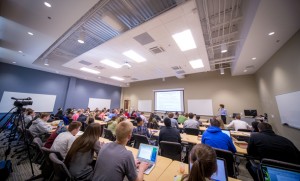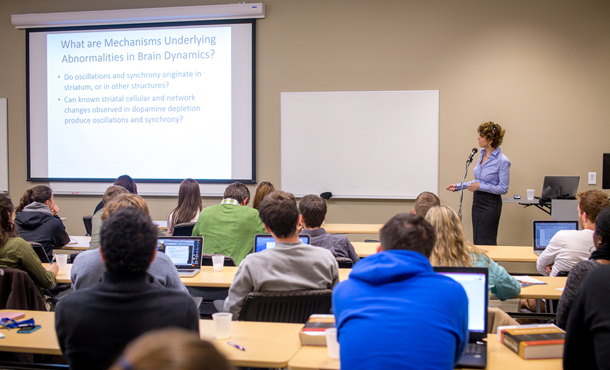No organ can even compare to the complexity of the human brain. It may be the only thing in the universe that can comprehend itself, but scientists still know very little about the brain. Will neurologists and computer programmers be able to model neural networks in the near future, or is a computer program that mimics nerves still the stuff of science fiction?
As it turns out, scientists like Kim Avrama Blackwell, a professor of molecular neuroscience at George Mason University, already describe neural networks with computers. Blackwell, speaking at a recent Suter Science Seminar at Eastern Mennonite University, showed how these computer models may provide researchers with the key to treating Parkinson’s disease.
Two computer programs for this modeling purpose, GENESIS, which stands for GEneral NEural SImulation System, and NEURON, are available to any online user.
These programs cannot model the entire brain, but they can help neurologists examine small parts of it. Blackwell’s research focuses on a very small network in the basal ganglia, primarily including the substantia nigra, which is Latin for “black stuff,” and the striatum, which is Latin for “striped.” These sections are very close to the center of the brain, and are responsible for movement of muscles.
The substantia nigra itself plays a role in learning habits of movement, such as walking and driving.
“When you’re not paying attention and you’re listening to music, yet you arrive at your destination, it’s because your basal ganglia has, without you thinking about it, done all the correct right turns,” said Blackwell, describing how habits work.
The substantia nigra helps this process by providing dopamine, a chemical vital to basic brain function, to the striatum, another part of the basal ganglia.
When the substantia nigra begins to die, however, less dopamine is released into the striatum. This causes Parkinson’s disease, a medical condition characterized by a hunched posture, a shuffling gait, and trembling. Several treatments exist, including use of L-DOPA or deep brain stimulation. The effects of the L-DOPA wear off over time, and deep brain stimulation is extremely invasive. Blackwell hopes to find another, more effective treatment.
In order to find treatments, scientists must understand Parkinson’s disease. One interesting effect of the disease, according to Blackwell, is that “all of the neurons [in the striatum] are firing at the same rhythm.” In healthy neurons, such synchrony is only intermittent, instead of constant. If Blackwell could understand why this happens, she might be one step closer to treating the disease.
Using computer models that replicate a network of neurons, Blackwell and her team discovered that gap junctions, a kind of bridge between neurons, may be responsible for the synchrony in the striatum. She predicts that, if the gap junctions could be blocked, the nature of the disease might change. Chemicals that block gap junctions might even be a useful treatment.
Blackwell spoke as part of EMU’s Suter Science Seminar series. Lectures are presented by experts in their field and are free and open to the public. Nancy Johnston, a nursing professor from York University, will speak April 13 at 4 p.m. about how the practice of healing suffering has changed over time.
